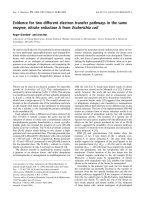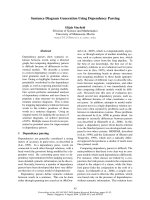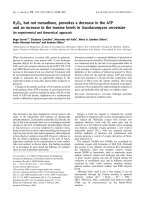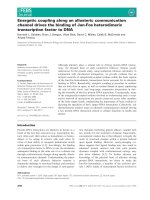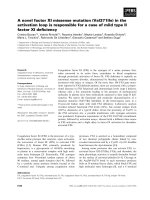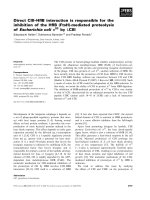Báo cáo khoa học: " Inverse planned stereotactic intensity modulated radiotherapy (IMRT) in the treatment of incompletely and completely resected adenoid cystic carcinomas of the head and neck: initial clinical results and toxicity of treatment" potx
Bạn đang xem bản rút gọn của tài liệu. Xem và tải ngay bản đầy đủ của tài liệu tại đây (228.95 KB, 6 trang )
BioMed Central
Page 1 of 6
(page number not for citation purposes)
Radiation Oncology
Open Access
Research
Inverse planned stereotactic intensity modulated radiotherapy
(IMRT) in the treatment of incompletely and completely resected
adenoid cystic carcinomas of the head and neck: initial clinical
results and toxicity of treatment
MW Münter*
1,3
, D Schulz-Ertner
3
, H Hof
3
, A Nikoghosyan
3
, A Jensen
3
,
S Nill
2
, P Huber
1,3
and J Debus
3
Address:
1
Department of Radiation Oncology, German Cancer Research Center (dkfz), Heidelberg, Germany,
2
Department of Medical Physics,
German Cancer Research Center (dkfz), Heidelberg, Germany and
3
Department of Radiation Oncology, University of Heidelberg, Heidelberg,
Germany
Email: MW Münter* - ; D Schulz-Ertner - ; H Hof - ;
A Nikoghosyan - ; A Jensen - ; S Nill - ; P Huber - ;
J Debus -
* Corresponding author
Abstract
Background: Presenting the initial clinical results in the treatment of complex shaped adenoid
cystic carcinomas (ACC) of the head and neck region by inverse planned stereotactic IMRT.
Materials: 25 patients with huge ACC in different areas of the head and neck were treated. At
the time of radiotherapy two patients already suffered from distant metastases. A complete
resection of the tumor was possible in only 4 patients. The remaining patients were incompletely
resected (R2: 20; R1: 1). 21 patients received an integrated boost IMRT (IBRT), which allow the
use of different single doses for different target volumes in one fraction. All patients were treated
after inverse treatment planning and stereotactic target point localization.
Results: The mean folllow-up was 22.8 months (91 – 1490 days). According to Kaplan Meier the
three year overall survival rate was 72%. 4 patients died caused by a systemic progression of the
disease. The three-year recurrence free survival was according to Kaplan Meier in this group of
patients 38%. 3 patients developed an in-field recurrence and 3 patient showed a metastasis in an
adjacent lymph node of the head and neck region. One patient with an in-field recurrence and a
patient with the lymph node recurrence could be re-treated by radiotherapy. Both patients are
now controlled. Acute side effects >Grade II did only appear so far in a small number of patients.
Conclusion: The inverse planned stereotactic IMRT is feasible in the treatment of ACC. By using
IMRT, high control rates and low side effects could by achieved. Further evaluation concerning the
long term follow-up is needed. Due to the technical advantage of IMRT this treatment modality
should be used if a particle therapy is not available.
Published: 06 June 2006
Radiation Oncology 2006, 1:17 doi:10.1186/1748-717X-1-17
Received: 20 March 2006
Accepted: 06 June 2006
This article is available from: />© 2006 Münter et al; licensee BioMed Central Ltd.
This is an Open Access article distributed under the terms of the Creative Commons Attribution License ( />),
which permits unrestricted use, distribution, and reproduction in any medium, provided the original work is properly cited.
Radiation Oncology 2006, 1:17 />Page 2 of 6
(page number not for citation purposes)
Background
Adenoid cystic carcinomas of the head and neck are a
unique kind of tumour deriving from cells of the major
and minor salivary glands, they account for 25% of all
malignant salivary gland tumours in different series.
Although ACCs are the most common histological type of
tumours in the minor salivary glands with a total of 55%
[1] they account for only about 10–15% of all parotid
gland malignancies. ACCs can be shown to be unique for
various reasons: first of all, these tumours often show a
protracted natural history. When compared to other
malignancies, a prolonged survival of patients with ACCs
is possible even in case of local recurrence or distant
metastases. Second, ACCs characteristically exhibit a
locally aggressive growth pattern with a unique tendency
to nervous tissue invasion. They might also spread greater
distances from the primary location by growing along the
nerve sheaths. In some cases, skip involvement can be
seen along the perineural space.
Hence, treatment of adenoid cystic carcinomas of the
head and neck presents a serious therapeutic challenge in
most cases. Surgical treatment is limited by the tumours'
growth pattern mentioned above. Despite complete gross
tumor resection due to paraneural spread in some cases
surgery is not radical. However, surgery is still the pre-
ferred treatment of ACCs but complete resection might
not always be possible or feasible if too many normal
structures are injured.
So radiation therapy often is an important part in the
treatment, either as postoperative therapy or as definite
treatment if a complete resection of the tumour is not pos-
sible [2,3]. However, the radiotherapeutic approach is
also similarly challenging due to numerous radiosensitive
structures in the head and neck region as doses ranging
between 60 and 70 Gy should be achieved in macroscopic
tumours. At these total doses normal tissue reactions in
curable disease is frequent and should be reduced by
introducing new planning technologies. Recent advances
in radiation oncology and treatment planning led to the
implementation of inverse planned intensity modulated
radiation therapy (IMRT). This treatment technique
allows the optimisation of target volume coverage while
allowing to reduce the dose to surrounding organs at risk.
Therefore an increased total dose could be achieved with
a better coverage of the target volume. Initial results using
IMRT show an improvement of local tumour control rates
and toxicity profiles in patients with tumours of the head
and neck [4-6]. The aim of this publication is to present
the inverse planned IMRT treatment technique, initial
clinical results, and toxicities in patients with complex
shaped ACCs of the head and neck.
Methods
Patients
25 patients with complex shaped ACCs were treated at our
institution with inverse planned IMRT. Their age ranged
between 30 and 80 years (median: 59 years) with 12
female and 13 male patients. The diagnosis of ACC was
confirmed histologically for all patients. 18 patients had
surgery aimed at total or subtotal resection of the tumour
before radiation therapy, 7 patients only had a biopsy of
the tumour for histological confirmation. According to
pathology reports, tumours could be completely resected
(R0) in 4 patients and with microscopic residuals (R1) in
one patient. In the remaining patients, surgery could only
achieve an R2 resection. At the time of radiation therapy,
2 patients already had lung metastases (M1), which
showed no progression in CT for more than 3 months at
the beginning of radiation therapy. Additionally, involve-
ment of cervical lymph nodes was histologically con-
firmed in 2 patients. Only one patient received
chemotherapy before radiation treatment. The anatomical
location of the ACCs treated is displayed in table 1.
Immobilisation
Adequate immobilisation is a crucial prerequisite for
obtaining the high accuracy needed for stereotactically
guided IMRT and therefore an important part of the defi-
nition of IMRT at our institution. Hence, a customised
individual immobilisation device depending on the
tumour location was created for each individual patient.
For treatment of lesions in the brain or base of skull the
patient was positioned supine with an individually made
mask which, at the German Cancer Research Centre
(dkfz), consists of Scotch Cast material wrapped around
the head of the patient. Serial 3 mm CT slices of the of the
whole treatment area plus a superior margin of 5 cm and
an adequate inferior margin to cover the neck lymph
nodes level I-III were acquired using a stereotactic head
frame. Contrast agent was administered according to our
in-house protocol. Additionally, a contrast MRI scan was
performed of the primary tumour area with the patient
also positioned in the individual mask and using a stere-
otactic head frame.
Table 1: Localization of the tumor
Tumor Localization Number of patients
Base of skull/Sinus maxillaris 17
Glandula lacrimalis 2
Tongue 2
Orbita 1
Trachea 1
Oropharynx 1
Acustic meatus 1
Radiation Oncology 2006, 1:17 />Page 3 of 6
(page number not for citation purposes)
Target definition
Target volumes and organs at risk were defined slice by
slice on the treatment planning CTs using the 3D-confor-
mal radiotherapy planning system VIRTUOS which was
developed at the dkfz. An image fusion of the treatment
planning CT and the MRI scan was performed for a more
accurate definition of the target volume and critical nor-
mal structures. Image registration was done stereotacti-
cally.
The CTV I was defined as the visible tumour volume in the
imaging studies plus a margin of 2 mm. For patient
treated after a complete resection the area of the tumours
visualized by preoperative scans was defined as CTV I.
CTV II was drawn around the CTV I with a generous mar-
gin depending on the anatomical relationship of adjacent
structures and potential microscopic spread. Areas with
potential subclinical disease, in particular the neurovascu-
lar sheaths in ACCs, were also included in the CTV II. The
ipsilateral lymph node level direct adjacent to the primary
tumor region was furthermore defined as CTV II in all
cases. Additional lymph nodes or lymph node level highly
suspicious for tumor in CT or MRI or after biopsy were
defined as CTV II This was necessary for two patients. One
of these two patients received treatment of bilateral lymph
node levels II and III. Volume of CTV I ranged between 50
to 896 cm
3
(Mean: 257 cm
3
) and for CTV II between 233
and 950 cm
3
(Mean: 433 cm
3
). Surrounding organs at risk
were also contoured slice by slice with special regard to
the spinal cord, brainstem, optical nerve, chiasm, and the
temporomandibular joint.
Treatment planning
KonRad inverse planning system developed at the dkfz
and now commercially available at Siemens Medical Solu-
tions was used for inverse treatment planning and was
linked to VIRTUOS for 3D dose calculation and visualisa-
tion. No additional margins were defined around the tar-
get volumes in the inverse treatment planning program.
In order to start the optimisation process in KonRad, the
user needs to define maximum and minimum dose con-
straints on both the target volumes and the organs at risk.
Moreover, penalties defining the relative importance of
the individual constraints have to be specified. Based on
these constraints and penalties, KonRad then uses an iter-
ative optimisation algorithm (gradient technique) in
order to improve the 3D dose distribution by minimising
the objective function. In addition to the dose specifica-
tions, the user is also able to select the couch, gantry, and
collimator angles as well as the number of intensity levels
representing the complexity of beam modulation in the
KonRad planning system. On optimisation, treatment
plans using 5, 7, or 9 equidistant gantry angles, coplanar
or non-coplanar couch position were evaluated in order
to define the beam arrangement with the best target vol-
ume coverage and normal tissue sparing. 4 to 8 non-zero
intensity levels were used to define the fluence map. An
integrated boost radiotherapy (IBRT) was optionally used
for patients with macroscopic tumors [16]. This IMRT
technique allows the treatment of various target volumes
simultaneously with various doses per fraction and in
turn allows escalation of the individual dose per fraction
to the CTV I.
The total doses for all target volumes were prescribed to
the median of the target volumes with 50% of the individ-
ual target volume receiving 100% of the total dose. At our
institution, the dose of all IMRT treatment plans is pre-
scribed to the median.
The maximum dose to the cervical spinal cord was limited
to 45 Gy while the maximum dose to the brainstem, the
optic nerve and chiasm was limited to 54 Gy. For the
remaining organs at risk the dose thresholds specified by
[17] were accepted. The target point of the IMRT treatment
was defined stereotactically and treatment was performed
on a step-and-shoot approach using a linear accelerator
with photon energies of 6 MV and 15 MV and integrated
multi-leaf collimator (MLC) (Siemens Medical Solu-
tions).
Follow-Up
The patients were seen regularly for clinical examination
during and after radiation therapy. Acute toxicity was
specified according to the Common Toxicity Criteria
(CTC) during treatment and 3 months afterwards. After 3
months, the RTOG/EORTC criteria for radiation late-
effects were used for evaluation. The first MRI scan of the
area treated was performed 6 weeks after radiation therapy
was completed. For the first 2 years after radiation ther-
apy, patients were followed up in intervals of 3 to 6
months including clinical examination and MRI scans.
Depending on clinical and radiological findings the
period between individual follow-ups was increased after
the second year. The measurement of follow-up was initi-
ated with the beginning of radiation therapy. The Kaplan-
Meier method was applied to analysis of overall survival,
disease-free survival, and control rate.
Results
Technical aspects
Integrated boost IMRT (IBRT) was performed in 21
patients. The median total dose delivered to the CTV I was
66 Gy (range: 58 – 70.4 Gy) and the median dose per frac-
tion to the CTV I was 2 Gy (range 1.8 – 2.2 Gy). Only in
one patient with an macroscopic ACC the dose of the CTV
I was lower than 60 Gy due to a diffuse infiltrating tumor
with a close relationship to the myelon and the brainstem.
Using the same number of fractions, the median total
Radiation Oncology 2006, 1:17 />Page 4 of 6
(page number not for citation purposes)
dose to the CTV II was 60 Gy (range 56 – 64.2 Gy) and the
median dose per fraction was 1.9 Gy (1.7 – 2.0 Gy). In
only 2 patients a non-coplanar beam set-up was used. The
median number of beams applied was 7 (range 5 – 9). The
total number of sub-segments for the step-and-shoot
IMRT approach ranged between 48 and 100 (median 75).
Approximately 6 segments per minute could be applied
by the system used. Therefore, the absolute treatment time
ranged between 8 and 16.7 minutes (median: 12.5 min-
utes). For rotation of the gantry to the next treatment posi-
tion approximately 8 sec. were needed. By two minutes
increased the treatment time if a movement of the table
for non-coplanar treatment was necessary. Additional 5
minutes were needed to position the patient in the mask
and for target point localisation and adjustment.
Outcome
The treatment schedule could be finished for all patients
as planned initially, and treatment interruptions were not
necessary for any longer than 2 days. Patients were fol-
lowed-up between 3 to 49.5 months (median 22.5
months). Radiological evaluation of the patients revealed
complete remission in 2 patients (8%), partial remission
in 6 patients (24%), and no change in the remaining
patients according to the WHO definitions. None of the
patients showed progression of disease under radiother-
apy and on the first follow-up (after 6 weeks). 3 patients
developed an in-field recurrence, and 3 patients had a pro-
gression of their disease in an adjacent lymph node. The
actuarial local control rate was 38% after the three years
(Figure 1). Additionally, 2 patients developed distant
metastases while local control was achieved. According to
Kaplan-Meier, the 3-year-progression-free-survival was
30%. One patient with in-field failure and one patient
with neck node recurrence could be re-treated with IMRT.
Both are controlled now. Including these 2 patients in the
analysis of the 3-year-progression-free survival this is
increased to 48% according to Kaplan-Meier. Unfortu-
nately, 5 patients died of their disease caused by systemic
progression in 2 patients and local failure in 3 patients.
Therefore, the overall survival in this patient group was
72% after 3 years (Figure 2). Analyzing the 5 patients sep-
arately receiving treatment after R1 or R0 resection only
one patients died caused by metastatic disease. All these
patients were locally controlled until now.
Treatment toxicity
Treatment had to be interrupted in only one patient for no
longer than 2 days due to acute side-effects. Severe acute
side-effects were mucositis grade III, seen in 5 patients
(20%), and mucositis grade II, seen in 11 patients (44%).
1 patient (4%) showed a grade III skin reaction while 11
patients (44%) showed a grade II skin reaction. In addi-
tion, a slight hair loss, nausea, inner ear effusion, and
xerostomia occurred during radiotherapy. Apart from the
xerostomia, these symptoms had completely disappeared
3 months after completion of radiotherapy. Xerostomia
grade II has so far been the only severe late-effect observed
in 5 patients.
Discussion
The data presented are able to support that IMRT is a safe
and feasible modality in the treatment of complex-shaped
ACCs in the head and neck. By using IMRT, high doses in
the GTV and PTV can be achieved together with an excel-
lent normal tissue sparing, especially bearing in mind the
dose-response relationship for ACCs described by various
authors. Garden et al. [7] could demonstrate significant
differences with respect to local control rates between
patients treated with doses of less than 56 Gy and patients
treated with more than 56 Gy. Hence, these authors are
recommending a dose of 60 Gy to the tumour bed and 66
Gy to the tumour bed in patients with positive margins.
Harrison at al. [8] could show a comparable effect using
Actuarial overall survival of the treated 25 patientsFigure 2
Actuarial overall survival of the treated 25 patients.
Loco-Regional control probability according to Kaplan-MeierFigure 1
Loco-Regional control probability according to Kaplan-Meier.
Radiation Oncology 2006, 1:17 />Page 5 of 6
(page number not for citation purposes)
doses of at least 57.5 Gy compared with lower doses for
histologically different major salivary gland tumours. The
authors found a reduced 10-year local control rate with
53% in patients treated with lower doses compared to
72% in patients treated with more than 57.5 Gy. Using
high doses to the CTV I in this study, an in-field recurrence
only occurred in 3 patients so far. Furthermore, IMRT
offers the advantage of treating various target volumes
with different doses per fraction. This results in a reduced
overall treatment time and increased doses per fraction to
areas with macroscopic disease. IBRT hence does also
have advantages especially with respect to radiobiology.
In this study, 21 out of the 25 patients were treated with
IBRT showing no increase in side-effects when compared
with the four patients treated with a conventional IMRT
regimen. All in all, acute and late side-effects were negligi-
ble in this study so far. No grade IV toxicity was seen, and
only 20% of the patients developed a grade III toxicity of
the mucosa. These results are comparable to the results
from a group of patients treated with photons in the study
of Huber et al. [9]. This study demonstrated similar acute
side-effects for patients treated with photons. Neverthe-
less, patients treated with neutrons showed increased late-
effects when compared to patients receiving photon radi-
otherapy.
Indications have to be defined for IMRT in the treatment
of ACCs when compared to radiotherapy regimen using
high relative biological effectiveness (RBE) beams. With
respect to high-RBE beams, the longest experience exists
using neutrons. The use of neutrons compared to photons
shows an advantage in most studies. The only prospective
randomised trial comparing neutrons and photons [11]
revealed an increased 2-year-survival rate with 62% in
patients treated with neutrons compared to 25% patients
treated with photons (p < 0.005). Additionally, the loco-
regional control rates at two years were 67% for neutrons
and 17% for photons (p = 0.10). The final report of this
study with a follow-up of ten years and 25 patients sup-
ports the initially published results demonstrating signifi-
cantly higher control rates in the treatment with neutrons
without improvement of overall survival [13].
Douglas et al. [14] published a huge trial of 151 patients
with non-resectable ACC treated with neutrons. The 5-
year-actuarial local control rate was 57% and the actuarial
overall survival was 72%. A retrospective trial by Huber et
al. [9] compared the results of our institution in the treat-
ment of ACCs to treatments with neutrons alone, with a
combination of neutrons and photons, and photons
alone. The local control rates were 75% for neutrons and
32% for the combined therapy as well as photons alone.
No differences could be observed with respect to the over-
all survival in this study. Promising results in reduction of
side effects and improvement of outcome were presented
by our group when combining IMRT and carbon ion ther-
apy as a boost treatment. In this prospective study pub-
lished by Schulz-Ertner et al. [15] there was no higher late
toxicity than CTC grade II so far. Additionally, the 3-year
actuarial overall survival rate was 83.3%. Only 3 patients
had a loco-regional recurrence at a median follow-up of
12 months.
Conclusion
The data presented in our study shows comparable results
to most studies using photon beams for the treatment of
ACCs. IBRT and IMRT with the tested dose concept is fea-
sible and results in a promising clinical outcome justify-
ing further investigations. Furthermore describes the IBRT
concept a promising approach to escalate the dose further
while reducing the treatment time.
A prospective study investigating the possible advantages
of IBRT plus carbon ion boost compared to IBRT alone
needs to be performed. Nevertheless, long-term results in
treatment of ACCs remain disappointing even applying
highly sophisticated radio-oncological treatment tech-
niques due to the high number of distant metastases.
Hence, future therapy of ACCs should also strongly focus
on improvement systemic treatment of this disease.
Authors' contributions
MWM, DSE, HH, AN performed the patient study and
treatment planning. Statistical analysis and patient fol-
low-up was done by AJ, MWM, SN and PH. Manuscript
was drafted by PH, MWM, JD. All authors read and
approved final manuscript.
References
1. Tran L, Sidrys J, Sadeghi A, Ellerbroek N, Hanson D, Parker RG: Sal-
ivary gland tumors of the oral cavity. Int J Radiat Oncol Biol Phys
1990, 18(2):413-417.
2. Guerney TA, Eisele DW, Weinberg V, Shin E, Lee N: Adenoid cystic
carcinoma of the major salivary glands treated with surgery
and radiation. Laryngoscope 2005, 115:1278-1282.
3. Silvermann DA, Carlson TP, Khuntia D, Bergstrom RT, Saxton J,
Esclamado RM: Role of postoperative radiation therapy in ade-
noid cystic carcinoma of the head and neck . Laryngoscope
2004, 114:1194-1199.
4. Lee N, Xia P, Quivey JM, Sultanem K, Poon I, Akazawa C, Akazawa P,
Weinberg V, Fu KK: Intensity-modulated radiotherapy in the
treatment of nasopharyngeal carcinoma: an update of the
UCSF experience. Int J Radiat Oncol Biol Phys 2002, 53(1):12-22.
5. Lee N, Xia P, Fischbein NJ, Akazawa P, Akazawa C, Quivey JM: Inten-
sity-modulated radiation therapy for head-and-neck cancer:
the UCSF experience focusing on target volume delineation.
Int J Radiat Oncol Biol Phys 2003, 57(1):49-60.
6. Munter MW, Thilmann C, Hof H, Didinger B, Rhein B, Nill S, Schlegel
W, Wannenmacher M, Debus J: Stereotactic intensity modu-
lated radiation therapy and inverse treatment planning for
tumors of the head and neck region: clinical implementation
of the step and shoot approach and first clinical results. Radi-
other Oncol 2003, 66(3):313-321.
7. Thilmann C, Zabel A, Grosser KH, Hoess A, Wannenmacher M,
Debus J: Intensity-modulated radiotherapy with an integrated
boost to the macroscopic tumor volume in the treatment of
high-grade gliomas. Int J Cancer 2001, 96(6):341-349.
Publish with BioMed Central and every
scientist can read your work free of charge
"BioMed Central will be the most significant development for
disseminating the results of biomedical research in our lifetime."
Sir Paul Nurse, Cancer Research UK
Your research papers will be:
available free of charge to the entire biomedical community
peer reviewed and published immediately upon acceptance
cited in PubMed and archived on PubMed Central
yours — you keep the copyright
Submit your manuscript here:
/>BioMedcentral
Radiation Oncology 2006, 1:17 />Page 6 of 6
(page number not for citation purposes)
8. Emami B, Lyman J, Brown A, Coia L, Goitein M, Munzenrider JE, Shank
B, Solin LJ, Wesson M: Tolerance of normal tissue to therapeu-
tic irradiation. Int J Radiat Oncol Biol Phys 1991, 21(1):109-122.
9. Garden AS, Weber RS, Morrison WH, Ang KK, Peters LJ: The influ-
ence of positive margins and nerve invasion in adenoid cystic
carcinoma of the head and neck treated with surgery and
radiation. Int J Radiat Oncol Biol Phys 1995, 32(3):619-626.
10. Harrison LB, Armstrong JG, Spiro RH, Fass DE, Strong EW: Postop-
erative radiation therapy for major salivary gland malignan-
cies. J Surg Oncol 1990, 45(1):52-55.
11. Huber PE, Debus J, Latz D, Zierhut D, Bischof M, Wannenmacher M,
Engenhart-Cabillic R: Radiotherapy for advanced adenoid cystic
carcinoma: neutrons, photons or mixed beam? Radiother Oncol
2001, 59(2):161-167.
12. Griffin TW, Krall JM, Russell KJ, Peters LJ, Thomas FJ, Hendrickson
FR, Laramore GE: Fast neutron irradiation of locally advanced
prostate cancer. Semin Oncol 1988, 15(4):359-365.
13. Laramore GE, Krall JM, Griffin TW, Duncan W, Richter MP, Saroja
KR, Maor MH, Davis LW: Neutron versus photon irradiation for
unresectable salivary gland tumors: final report of an RTOG-
MRC randomized clinical trial. Radiation Therapy Oncology
Group. Medical Research Council. Int J Radiat Oncol Biol Phys
1993, 27(2):235-240.
14. Douglas JG, Laramore GE, Austin-Seymour M, Koh W, Stelzer K,
Griffin TW: Treatment of locally advanced adenoid cystic car-
cinoma of the head and neck with neutron radiotherapy. Int
J Radiat Oncol Biol Phys 2000, 46(3):551-557.
15. Schulz-Ertner D, Nikoghosyan A, Jakel O, Haberer T, Kraft G, Scholz
M, Wannenmacher M, Debus J: Feasibility and toxicity of com-
bined photon and carbon ion radiotherapy for locally
advanced adenoid cystic carcinomas. Int J Radiat Oncol Biol Phys
2003, 56(2):391-398.


